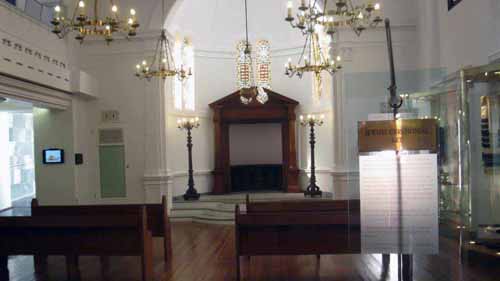
By Garry Fabian
CAPE TOWN, South Africa — While the Jewish population in South Africa has diminished over the last decade as many have emigrated to the US, Australia, Israel and other parts of the world, there is still a substantial number living in the country.
We recently spent a week in Cape Town, where there still is a Jewish presence numbering in excess of 15,000, and it boast numerous synagogues covering a wide spectrum of observances.
We stayed in what is loosely described as “the Jewish” area, the delightful suburb Sea Point, and found four synagogues within a few minutes from our accommodation. There is a Chabad House, a Youth Synagogue, a traditional synagogue that was opened in 1934, as well as Liberal synagogue. All are fully functioning with daily services, as a well developed community and social programs.
The other point of interest is the Jewish Museum and a formal synagogue in the heart of the business district, and an adjacent Holocaust Museum.
There currently is a very interesting exhibition at the Museum: “District 6”.
District 6 was as section of Cape Town where mixed races lived together in harmony, and most of the Jewish immigrants from Eastern Europe settled in the 19th century and established a replica and lifestyle of the shetl of their origins.
In the 1960’s the then Government decided to clear the area with a view of urban renewal, and some 40,000 black Africans were displaced into settlements, while the Jewish population became absorbed in the mainstream of urban life.
The story of District 6 is a sad one, and is described by many South Africans “as a blot on Cape Town. The urban renewal never took place and today the sizeable area of the city is still a wilderness of grass and weeds.
The current special Museum display has recreated the stetl and depicts faithfully the life style and daily happenings of the day.
The Holocaust Museum is also impressive, both in architectural style and its very well presented exhibition material. While we were visiting a large group of school children toured, and I believe that the children of those who experienced the total injustices of Apartheid, which is still a very strong factor in today’s South African memories, may have a very real understanding the of Holocaust.
On a personal note I found Cape Town a very impressive and beautiful city with many attractions, as well as a historical link with such places a Robben Island that was the prison where Nelson Mandela and many others spend decades in confinement.
But the one feature of the city, and I understand the rest of South Africa, that really disturbed me, was the level of security. While I have been told that this is now a feature of many American cities, the presence of high electrified fences and barriers at every private home, gates that have to be unlocked before you can enter a shop in the main street, security guards at every commercial building. This to us living in the free and easy environment in Australia, presents an alien and unwelcome reminder of the strained lifestyle there, and goes a long way to explain while there are some many South Africans who have emigrated to Australia and are playing a very important part in strengthening the Australian Jewish community in a very positive way.
*
Fabian is a freelance writer based in Melborne, Australia. He may be contacted via garry.fabian@sdjewishworld.com